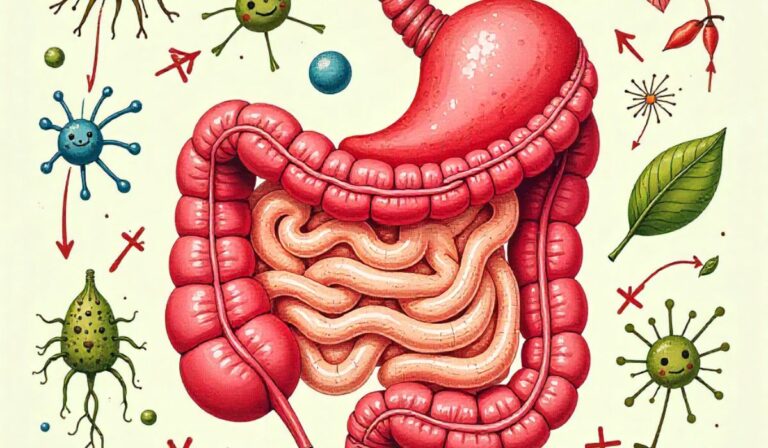Discover How Fiber Supports Digestive Health
I remember the days when I had digestive issues. I didn’t know changing my diet could help. Adding more fiber was a big change, and I want to share it with you.
Fiber is key for a healthy digestive system. It keeps bowel movements regular, stops constipation, and helps good gut bacteria grow. Learning about fiber’s benefits is the first step to a healthier gut.
Exploring fiber’s role in digestive health will help you make better diet choices. This article will show you how fiber boosts your overall health.

Key Takeaways
What Is Dietary Fiber? Understanding the Basics
Starting your journey to better digestive health means learning about dietary fiber. It’s the parts of plant foods your body can’t digest or absorb.
Unlike fats, proteins, or carbs, fiber isn’t broken down into nutrients. It moves through your stomach, small intestine, and colon, playing a key role in your digestive health.

Soluble vs. Insoluble Fiber: Key Differences
Dietary fiber has two main types: soluble and insoluble. Soluble fiber turns into a gel-like substance when mixed with water.
It helps lower cholesterol and control blood sugar. You can find it in oats, barley, nuts, seeds, and some fruits and veggies.
Insoluble fiber, on the other hand, doesn’t mix with water. It adds bulk to your stool and helps with regular bowel movements. You can find it in whole grains, wheat bran, and veggies.
https://gigasecurehome.com/how-many-blink-cameras-can-you-have-on-one-module
How Fiber Moves Through Your Digestive System
Fiber does many important things as it moves through your body. In your stomach and small intestine, it slows down digestion.
This helps your body absorb nutrients better. In your colon, fiber is broken down by bacteria, creating acids that feed your colon’s lining.
Fiber also makes your stool softer and bulkier. This makes it easier to pass and lowers the risk of constipation. Its journey through your digestive system shows how vital fiber is for a healthy gut.
The Role of Fiber in Digestive Health
Fiber is key for a healthy digestive system. It affects bowel movements and the gut microbiome. It helps with regular bowel movements, a balanced gut, and prevents digestive disorders.
How Fiber Promotes Regular Bowel Movements
Fiber makes stool bulkier and softer, making it easier to pass. This is vital for avoiding constipation, common in those who don’t eat enough fiber.
Soluble fiber in foods like oats and barley softens stool. Insoluble fiber in whole grains and veggies adds bulk.

Fiber’s Impact on Gut Microbiome
The gut microbiome is vital for health. Fiber feeds the good bacteria in the gut, keeping the balance right.
Prebiotic Effects of Fiber
Fiber’s prebiotic effects help beneficial bacteria grow. This boosts the gut microbiome’s diversity and function. It strengthens the immune system and improves health.
Bacterial Diversity and Health
A diverse gut microbiome leads to better health, including better digestion and disease prevention. Fiber intake boosts bacterial diversity.
| Fiber Type | Food Sources | Benefits |
|---|---|---|
| Soluble Fiber | Oats, barley, fruits | Softens stool, lowers cholesterol |
| Insoluble Fiber | Whole grains, vegetables | Adds bulk, promotes regular bowel movements |
Preventing Digestive Disorders with Adequate Fiber
Fiber helps prevent digestive issues like diverticulitis, hemorrhoids, and IBS. It keeps bowel movements regular and the gut healthy, playing a big role in digestive health.
https://gigasecurehome.com/2-ring-doorbells-on-one-transformer
7 Key Benefits of Fiber Beyond Digestion
Fiber is not just good for your digestion. It also boosts your overall health in many ways. A high fiber diet can improve your well-being in several key areas.
Weight Management and Satiety
Fiber helps with weight control by making you feel full longer. Foods high in fiber digest slowly, which helps prevent overeating. This is great for those trying to lose or maintain weight.
Blood Sugar Regulation
A high fiber diet can also control blood sugar levels. It slows down sugar absorption into the blood. This is good for people with diabetes or those at risk.
Heart Health and Cholesterol Reduction
Fiber is good for your heart by lowering cholesterol. Soluble fiber binds to bile acids, helping remove them from the body. This can lower cholesterol production.
Cancer Prevention
Some studies link a high-fiber diet to lower cancer risk, like colorectal cancer. More research is needed, but the signs are promising.
Adding more fiber to your diet can greatly improve your health. It helps with weight, blood sugar, heart health, and even cancer prevention. By knowing the benefits of fiber, you can make better choices for your well-being.
How Much Fiber Do You Really Need? Daily Recommendations
Fiber is key to a healthy diet, but how much do we need? Knowing the daily fiber intake is vital for good digestion and health.
Age and Gender-Specific Guidelines
The amount of fiber we need changes with age and gender. The Dietary Reference Intake (DRI) sets these guidelines. Here’s what they say:
- Men aged 50 and below: 38 grams
- Men over 50: 30 grams
- Women aged 50 and below: 25 grams
- Women over 50: 21 grams
These are average needs. Your actual needs might be different based on your health, activity level, and more.
The Fiber Gap: Why Most Americans Fall Short
Most Americans don’t get enough fiber, despite clear guidelines. This is called the “fiber gap.”
Common Barriers to Adequate Fiber Intake
Several things make it hard to get enough fiber, including:
- Lack of awareness about fiber’s importance
- Diets high in processed foods and low in whole foods
- Busy lifestyles that make meal planning challenging
Consequences of the Fiber Gap
Not getting enough fiber can harm our health, leading to:
- Constipation and other digestive issues
- Increased risk of chronic diseases like heart disease and diabetes
- Potential impact on weight management
Understanding these challenges and consequences is the first step towards making positive changes to our diets and improving our overall health.
Top 15 Fiber-Rich Foods to Add to Your Diet
Adding fiber-rich foods to your diet is easy and good for your digestion. There are many tasty options to choose from. This way, you can easily get enough fiber every day.
Fruits Packed with Fiber
Fruits are not just tasty, but also full of vitamins and minerals. They are also rich in fiber. Berries, bananas, and apples are some of the best choices.
Berries: Nature’s Fiber-Rich Candy
Berries like raspberries, strawberries, and blueberries are very high in fiber. For example, a cup of raspberries has about 8 grams of fiber. You can enjoy them as a snack, add them to oatmeal, or blend them into smoothies.
Other High-Fiber Fruits to Enjoy
Bananas, apples, and oranges are also great for fiber. A medium apple with skin has about 4.5 grams of fiber. Eating a variety of these fruits helps you reach your daily fiber goal.
Vegetables That Boost Your Fiber Intake
Vegetables are also key for fiber. You can eat them raw in salads or cooked in stews.
Leafy Greens and Cruciferous Vegetables
Leafy greens like spinach and kale are full of fiber and vitamins. Broccoli and cauliflower are also high in fiber and offer health benefits.
Root Vegetables and Other Fiber Stars
Carrots, beets, and sweet potatoes are rich in fiber and versatile. You can roast, mash, or add them to soups for a healthy meal.
Whole Grains, Legumes, and Other Fiber Powerhouses
Whole grains and legumes are top fiber sources. Foods like brown rice, quinoa, lentils, and chickpeas are not only high in fiber but also in protein and nutrients.
Some examples of high-fiber whole grains and legumes include:
- Quinoa
- Brown rice
- Lentils
- Chickpeas
- Black beans
As “The American Heart Association recommends at least 25 grams of fiber per day for optimal health.” Adding these fiber-rich foods to your diet helps you meet this goal and supports your health.
Signs You’re Not Getting Enough Fiber
Knowing the signs of low fiber intake is key for good digestive health. Fiber is vital for digestion and lacking it can cause health problems.
Digestive Symptoms of Fiber Deficiency
Fiber is key for a healthy fiber digestion process. Not getting enough can lead to several digestive symptoms.
Constipation and Irregular Bowel Movements
Constipation or irregular bowel movements are common signs of fiber deficiency. Fiber helps food move through your system. Without enough, constipation can be a problem.
Digestive Discomfort and Bloating
Not enough fiber can cause digestive discomfort and bloating. It helps keep the gut microbiome balanced. Without it, this balance can be disrupted.
Other Health Indicators of Low Fiber Intake
Low fiber intake affects more than just digestion. It impacts overall health, not just fiber for digestion.
Energy Levels and Mood Changes
Some notice energy or mood changes without enough fiber. This is because fiber affects blood sugar and gut health.
Long-term Health Implications
Long-term, not enough fiber can lead to heart disease and some cancers. It’s important to eat enough fiber for long-term health.

By recognizing these signs and adjusting your diet, you can boost your digestive health and overall well-being.
My Practical Tips for Increasing Your Daily Fiber Intake
I’m passionate about nutrition and have found simple ways to boost fiber intake. Adding a high fiber diet to your day can help in many ways. It can improve bowel movements and support a healthy gut.
Simple Meal and Snack Swaps
Boosting fiber is easy with simple swaps. Choose whole grain bread over white and brown rice over white. Here are more ideas:
- Replace regular pasta with whole wheat pasta
- Snack on fruits and nuts instead of chips
- Choose high-fiber cereals for breakfast
Gradual Implementation Strategies
Increasing fiber should be done slowly. Start by adding fruits or veggies to your meals. Gradually increase the amount to avoid discomfort.
Tips for gradual implementation:
- Begin with an additional serving of fiber-rich foods per day
- Gradually increase the serving size over a week or two
- Monitor your body’s response and adjust if needed
Delicious High-Fiber Recipes to Try
Adding high-fiber recipes to your diet is easy and tasty. Here are some ideas for different meals:
Breakfast Options
Try oatmeal with fruits and nuts or whole grain toast with avocado.
Lunch and Dinner Ideas
Try lentil soup, grilled veggies with quinoa, or whole grain pasta with marinara and sautéed veggies.
Fiber-Rich Snacks and Desserts
Enjoy apple slices with almond butter, carrot sticks with hummus, or dark chocolate with nuts.
By following these tips and trying new recipes, you can easily increase your fiber intake. Remember, the key is to do it gradually and make lasting changes.
When Too Much Fiber Becomes a Problem
Too much fiber can cause uncomfortable side effects. While it has many health benefits, eating too much can lead to problems. This might make people not want to eat a lot of fiber.

Common Side Effects of Excessive Fiber
Too much fiber can cause digestive issues. The main problems are discomfort and trouble absorbing nutrients.
Digestive Discomfort and Gas
Eating too much fiber, like soluble fiber, can cause bloating, gas, and stomach cramps. This happens because fiber is broken down by bacteria in the colon, making gas. Increasing fiber intake gradually can help lessen these issues.
Nutrient Absorption Issues
A diet high in fiber can make it hard to absorb some minerals. This is a big worry for people who don’t get enough nutrients. Eating a balanced diet and watching your fiber intake can help avoid this problem.
How to Find Your Fiber Sweet Spot
Finding the right amount of fiber is key. It helps you get the most benefits without the side effects. There are two main ways to find this balance.
Gradual Increase Techniques
It’s better to slowly increase your fiber intake. This lets your gut adjust, reducing discomfort. Start with small amounts and see how your body reacts to find the best fiber level.
Hydration and Fiber Balance
Drinking enough water is important when eating a lot of fiber. Water helps fiber move through your body, preventing constipation. It’s best to drink plenty of water all day, when you’re eating more fiber.
Fiber Supplements: Do You Need Them?
Fiber supplements are getting more popular. But do you really need them for your digestive health? Many people are using them to get enough fiber in their diet.
Types of Fiber Supplements Available
There are many types of fiber supplements. Each one has its own special features. The most well-known are psyllium, methylcellulose, and polycarbophil.
Psyllium, Methylcellulose, and Other Options
Psyllium is a favorite for helping with regular bowel movements. Methylcellulose also supports healthy digestion. Other options include polycarbophil and inulin.
Natural vs. Synthetic Fiber Supplements
Fiber supplements can be natural or made in a lab. Natural ones, like psyllium, are often chosen for their gentle effect on digestion. Synthetic ones, like methylcellulose, are for specific needs.
How to Choose the Right Supplement for Your Needs
Choosing the right fiber supplement depends on your health goals and any sensitivities. It’s important to consider these factors.
When Supplements Make Sense
Fiber supplements are good for those who can’t get enough fiber from food. They also help with certain digestive problems.
Potential Interactions and Considerations
Think about how fiber supplements might interact with your medications. Always talk to a doctor before starting a new supplement.
In summary, fiber supplements can be helpful if you choose the right one. Knowing the different types and what you need helps you make a smart choice.
Special Fiber Considerations for Different Life Stages
Our fiber needs change as we grow older. Fiber is key for good digestion and keeping our gut healthy. But, how much we need varies with age.

Children and Fiber Requirements
Children need different amounts of fiber than adults. Their daily fiber needs depend on their age and how many calories they burn.
For example, kids aged 1-3 need about 19 grams of fiber each day. Kids aged 4-8 should get around 25 grams.
It’s important to feed them foods high in fiber like fruits, veggies, and whole grains. This helps them grow strong and healthy.
Pregnancy and Fiber Needs
When a woman is pregnant, her fiber needs stay the same as before. But, it’s very important to eat enough fiber to avoid constipation. Pregnant women should aim for 28 grams of fiber daily.
Eating foods high in fiber can also help control blood sugar and keep a healthy weight.
Fiber Intake for Older Adults
As we get older, our digestive system changes. Older adults might need more fiber to prevent constipation.
For those over 50, men should get about 30 grams of fiber daily, and women should aim for 21 grams.
Eating more whole foods like fruits, veggies, and whole grains can help with healthy aging.
In summary, knowing how much fiber we need at different ages is important for good digestion. Eating the right amount of fiber at each stage helps us stay healthy and avoid digestive problems.
Embracing a Fiber-Rich Lifestyle for Long-Term Digestive Health
A fiber-rich lifestyle is key for long-term digestive health. Fiber helps with regular bowel movements and supports a healthy gut. It’s essential for our digestive system.
Adding fiber to our diet can greatly improve our health. It helps prevent digestive problems, aids in weight management, and boosts heart health. These benefits are significant.
To enjoy these advantages, start by slowly increasing your fiber intake. Eat a variety of fiber-rich foods like fruits, veggies, whole grains, and legumes. This will help you adopt a fiber-rich lifestyle for better digestive health.
FAQ Of Discover How Fiber Supports Digestive Health
What is the recommended daily intake of fiber?
Adults need 25-30 grams of fiber each day. This amount changes based on age and gender.
Can a high-fiber diet help with weight management?
Yes, it can. High-fiber foods make you feel full. This can help you eat fewer calories.
Are fiber supplements as effective as a high-fiber diet?
Fiber supplements are helpful. But, eating whole foods is better for your health and digestion.
Can too much fiber cause digestive issues?
Yes, eating too much fiber can upset your stomach. It may cause gas and bloating. So, it’s important to find the right amount for you.
How can I increase my fiber intake gradually?
Start by adding a serving of high-fiber foods to your meals each day. Slowly increase the amount over time.
What are some high-fiber foods that are easy to incorporate into my diet?
Try adding fruits like apples and bananas, and veggies like broccoli and carrots. Also, include whole grains like brown rice and quinoa.
Can a high-fiber diet help prevent certain digestive disorders?
Yes, it can. A high-fiber diet helps prevent constipation, diverticulitis, and hemorrhoids. It keeps your bowel movements regular and supports a healthy gut.
Are there any specific fiber-rich foods that are beneficial for gut health?
Yes, foods like asparagus, onions, and whole wheat bread are good. They are rich in prebiotic fiber, which helps beneficial gut bacteria grow.

![Internal Shower Drinks Facts, Myths, and Hydration Strategies[1]](https://mycleanseplan.com/wp-content/uploads/2025/11/Internal_Shower__Drinks__Facts_Myths_and_Hydration_Strategies1-768x448.jpg)
![How to Safely Reintroduce Food After Gut Reset[1]](https://mycleanseplan.com/wp-content/uploads/2025/10/How_to_Safely_Reintroduce_Food_After_Gut_Reset1-768x448.jpg)

![Gut Focused Nutrition for Women Hormones Menopause Cycle[1]](https://mycleanseplan.com/wp-content/uploads/2025/11/Gut_Focused_Nutrition_for_Women_Hormones_Menopause_Cycle1-768x448.jpg)

![Herbal & Botanical Gut Support Protocols Explained[1]](https://mycleanseplan.com/wp-content/uploads/2025/10/Herbal__Botanical_Gut_Support_Protocols_Explained1-768x448.jpg)